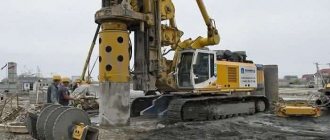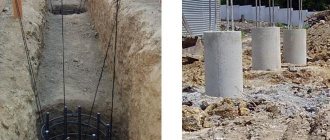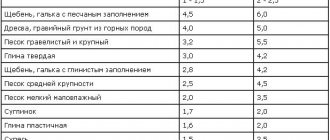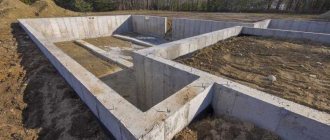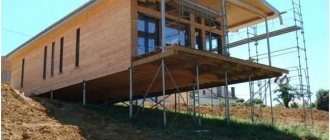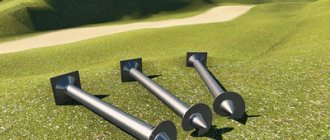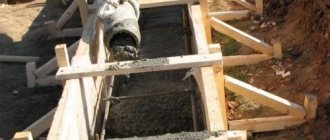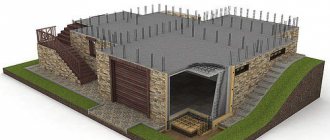Scheme of a bored foundation Bored foundations are often used for the construction of light residential and commercial structures on areas with a large slope or on heaving soils. Houses built on stilts are practically not subject to vertical and horizontal displacement, are durable and can be erected fairly quickly.
Also, with the help of bored piles, you can quickly repair an existing foundation, and reconstruction can be carried out on an area with a limited area.
Design features
Image of a finished pile foundation for a house
Advantages of bored foundations:
- This is an economical type of foundation; there is no need to use a large amount of concrete and reinforcement, while the piles themselves can be deepened to great depths.
- The base does not require the manufacture of removable formwork. The grillage is made with permanent formwork; you can use available building materials, even wooden beams or boards.
- It is easy to build it yourself without the use of special construction equipment.
- The house is being built on a limited area of land.
The average service life of a pile is about 100 years; if it is damaged, it can be promptly replaced without dismantling the building itself.
Disadvantages of bored piles:
- Their use is limited by the permissible weight of the building itself, so it is realistic to build only light structures on such foundations.
- It is technically impossible to build a ground floor or basement.
- It is impossible to build a foundation without a detailed design.
- There is a large dependence of the type and load-bearing capacity of the pile on the characteristics of the soil at various depths.
Considering that most bored piles are factory products, they are manufactured to strictly specific sizes, diameters and characteristics. The calculation of their number and type is carried out after the development of a detailed design of the future building. At the design stage, a detailed geodetic analysis of the soil structure on the site is carried out.
In what ways can wells be drilled on site?
Each developer who will independently create load-bearing structures for residential or commercial buildings must use the guidelines for the design and construction of foundations made of bored piles. The process of carrying out such work requires strict adherence to technologies and approved standards. After conducting geological surveys and determining the type of soil on the site, the developer must begin drilling wells. To do this, you can use several methods:
- Drilling by hand. To use this technique, the developer needs to purchase or rent a drill. In the process of creating a well, he will have to exert great physical effort. If the site has rocky soil, it will be very difficult to manually drill to the required depth. Once the developer manages to create the required number of holes, he can begin pouring the bored pile one by one with his own hands.
- Creation of wells using a gasoline drill. This method will significantly speed up the workflow. The developer will not need to exert much physical effort and will be able to accurately plan the number of holes that can be created per day. Before starting work, he should familiarize himself with a thematic video that will help minimize errors, teach how to make holes in different types of soil, and optimize work processes.
- Drilling wells using specialized equipment. To use this technique, the developer should ensure unhindered access to the construction site for equipment. As a rule, such machines are equipped with long booms, thanks to which they can drill several wells from one place.
After their creation, the developer should pour concrete as soon as possible, since unfavorable weather conditions can cause the walls of the holes to collapse. If this happens, you will have to call in equipment to clean out the wells, which will ultimately affect the cost of the foundation structure.
Stages of designing a columnar foundation made of bored piles
Technology for creating a pile foundation with a grillage
Detailed geodetic exploration of the construction site, sampling of vertical core and its analysis are carried out. Next, it is necessary to calculate the minimum permissible soil resistance at the calculated depth, as well as determine the level of groundwater and the depth of soil freezing.
It is important to calculate the maximum possible mass of the future building, taking into account the grillage and the mass of the pile itself. You should also calculate the minimum number of pillars on which the grillage will then be installed.
When designing bored foundations, the following must be taken into account:
- the pillars must completely transfer the load from the house building to the ground; it is for this reason that the bearing capacity of the soil is calculated. If you need to increase the permissible load, then the method of widening the base of the pillar is used (the average diameter of the base is 40-60 cm);
- the interval between piles should not exceed 1.5−2 meters. An interval of 3 meters is allowed, but only for light structures.
So, the main sections of the bored foundation project:
- Calculation of the maximum permissible mass of the building.
- Determination of soil bearing capacity.
- Calculation of the load on one pile and the choice of its design.
- Sketch design of the foundation with indicated distances between piles.
- Calculation of the required amount of concrete and reinforcement for pouring piles.
There may be other sections of such a project, but without calculating the maximum permissible loads on the ground, the design and laying of this type of foundation cannot be carried out.
Practical advice
Creating bored piles with reinforcing bars
Basic tips for designing pile foundations:
- the minimum permissible immersion depth of the pile base must be at least 100−150 mm below the soil freezing line;
- they cannot be used in the construction of heavy concrete buildings. In this case, it is better to design column-type foundations with a concrete base;
- strictly adhere to the step between piles, it is better to provide a margin of safety;
- When designing a grillage, always take into account ventilation holes - vents.
Technology for constructing a bored foundation
Schematic representation of the constituent elements of a bored foundation.
First of all, a preliminary design of the future foundation is developed and linked to the situational general development plan. Next, you should:
- determination of elevation differences;
- marking the foundation axes and indicating key points for drilling wells;
- drilling wells manually or with a motor drill;
- installing pipes into the resulting wells, leveling the upper edge of the pipes horizontally, filling the resulting space between the pipe and the well wall with sand;
- aligning the pipe vertically;
- installation of reinforcement cage in pipes;
- pouring concrete with its further compaction;
- arrangement of formwork for grillage.
At the end of all work, the reinforcement frame for the grillage is laid and the fittings are connected to the pipes. The last step is pouring the grillage.
The nuances of using casing pipes
The use of casing pipes allows you to avoid such a negative phenomenon as shedding of earth from the walls of the well being created. Due to this, pipes of this type are actively used not only to create foundation structures in industrial and civil construction, but also to strengthen the walls of gas, water and oil wells. The structure of casing pipes is made up of individual sections of such products, connected to each other by welding or using special clamping devices (such as “Kato”, “Betono”, etc.).
After the reinforcement cage used for installing bored piles is placed in the inside of the casing pipes and the concrete solution is poured, the pipes themselves are removed. In some cases, if stipulated by the requirements of the project, the technology allows leaving the casing pipes in place.
Installation of reinforcement cage inside the casing pipe
Modern manufacturers produce casing pipes of various diameters, which makes it possible to optimally select such products for constructing wells for various purposes. International regulatory documents that stipulate requirements for the geometric parameters of casing pipes are the Leffer and Bauer standards. According to the requirements of these standards, the internal diameters of casing pipes for bored piles can be in the range of 620–2500 mm, and the external diameters range from 640 to 2580 mm.
Various techniques are used to lower the casing into a pre-prepared well. The most common are:
- driving of casing pipes, for which special vibration equipment is used;
- immersion of casing pipes using drilling, which can be carried out using percussion or rotational techniques.
Rotating casing installation
The use of the rotational technique involves first drilling a hole in the ground for the first section of the pipe, for which all necessary measurements are first taken. After the first section of the casing pipe is immersed in the prepared well, its second section is drilled, while also focusing on the geometric parameters of the corresponding section. Thus, by performing step-by-step drilling and immersing interconnected sections of casing pipes, the entire pipe structure for the bored pile is installed.
The essence of the impact method for installing casing pipes is that sections of pipes are simply driven into the ground, for which special equipment is used. The settlement of pipes, carried out using this technology for installing bored piles, can be carried out ahead of or with some lag in relation to the face being performed. It all depends on the characteristics of the soil in which the well is drilled (in particular, on its permeability).
Existing grillage options
Scheme of reinforcement for a bored foundation
In some cases, when designing bored foundations, the customer initially asks to make a specific type of grillage. At the moment, hanging and shallow grillages remain popular.
In the case of designing a hanging grillage, a height reserve of about 20-30 cm remains between it and the soil surface. This gap neutralizes the impact of the soil on the house, but at the same time an open space is formed under the floor, which needs to be additionally insulated.
Also, this version of the house design provides the opportunity to eliminate large uneven soils, because it is possible to provide piles of various lengths.
But shallow grillages are slightly dug into the ground, and to eliminate the effect of swelling of the soil you need to use a sand and gravel cushion. The thickness of the pillow is selected based on real geological factors, as well as the mass of the house.
Foundation on bored piles
In most cases, when we talk about a bored foundation, we are talking about bored piles as an element, for example, of a pile-strip foundation. Of course, you can use bored piles directly as a foundation, without tying them with a concrete strip, for example, for a fence, a shed or a small bathhouse. But for a private house, it is more justified to use a pile-tape or pile-grillage foundation, in which all these piles are rigidly connected to each other by a concrete strip (grillage). This tape, firstly, distributes the load between the piles, secondly, it rigidly connects the entire structure of the future building and thirdly, it forms the foundation for the load-bearing walls of the house.
How to make bored foundations with widening?
Installation diagram of bored piles with widening
When designing some buildings, especially complex structures, developers use the term “widening”. This term means that the diameter of the pile base is artificially increased and, as a result, the maximum permissible load of one support on the ground increases.
The widening is done manually directly at the construction site. A well is drilled to a given depth and the formwork is lowered into the middle.
Then it's time to fill the hole with concrete. This is done in two stages: first, the heel is filled with concrete and the formwork is raised to the height of the widening. The freed column of concrete fills the heel completely and hardens.
While the solution has not hardened, the reinforcement cage is mounted to a given depth, the pillars and reinforcing belt are aligned, and fixed horizontally and vertically. The pillar is completely filled with concrete.
Technology for installing bored piles under the protection of inventory pipes
Bored piles protected by inventory pipes are one of the most practical ways to construct a building foundation. In order to increase the load-bearing capacity, they are made with widening at the bottom (widening of the pile heel). After drilling a well, which is carried out under the protection of an inventory pipe, a frame is installed in it, and the well is filled in portions with concrete mixture. After completing this work, the inventory pipe is removed from the well in sections. During drilling, soil is removed from the surface and loaded onto vehicles for transportation to the landfill.
Equipment used:
- Drilling rigs: LIEBHERR LB-24,28, inventory casing and concrete pipes, bucket auger.
Installation of piles under the protection of inventory pipes on various types of soil
Due to the fact that these piles can be installed to great depths with a large diameter, they can be used even on a landslide-prone slope.
In waterlogged soils, the installation of bored piles under the protection of inventory pipes is temporarily longer than the installation of pile piles using the CFA technology. The sinking of the well, which is possible due to the presence of groundwater, is delayed by casing pipes. After the concrete is poured, the casing is removed. The use of casing pipes greatly slows down the pace of construction and increases its cost. Sometimes an alternative method is used - instead of casing pipes, the well is filled with a special solution (bentonite or polymers). Due to the pressure, the solution holds the well and it becomes possible to continue pumping concrete. This method also increases the cost of construction and slows down its pace. In addition, the environmental factor is also important here: part of the solution inevitably ends up on the soil surface, which leads to deterioration of the environment. In weak soils, constructing a foundation using this method will inevitably lead to their restructuring. As a result of such processes, the volume of drilled soil can be significantly greater than the volume of the trunk. This threatens uneven settlement of buildings, the appearance of cracks and deformation of structures. Subsequent soil subsidence may reach a level below the design level. When passing through water-saturated soils, it is necessary to create back pressure in the well by filling it with clay solution or water, or create an extended soil plug. The use of an inventory pipe allows you to cover the horizon of water-saturated soils, ensure control of pile parameters and the safety of drilling operations, as well as guarantee high-quality filling of the pile with concrete.
Advantages of bored piles protected by inventory pipes
The main advantage of bored piles is the ability to install them to great depths and large diameters. The use of such piles has proven itself in cases where the structure will be subject to heavy loads during operation.
Bored piles are successfully used under the protection of inventory pipes in places of spot construction, in cramped urban conditions, and also in cases where construction is taking place near erected buildings. In such cases, during the construction of the foundation, nearby buildings do not suffer, since there are no dynamic loads. Deformation of soils and crumbling of the walls of structures are also excluded. In addition, the maintenance of the construction site is simplified, water consumption is reduced and, naturally, costs are reduced.
Other advantages of bored piles protected by casing pipes include:
- error-free control of the drilling process, allowing you to detect the achievement of the bearing layer;
- possibility of crushing boulders;
Due to its high reliability, this type of pile is the most popular among bridge and transport builders.
